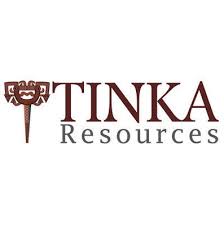![]() Tinka Resources {TSX.V: TK}
Tinka Resources {TSX.V: TK}
Provided assay results for two recent holes drilled at the company’s 100-per-cent-owned Ayawilca property in central Peru.
Results included 5.7m of 32.6% Zinc.
.
.
.

.
.
.
Tinka Resources drills 5.7m of 32.6% Zn at Ayawilca
2019-09-05 05:33 ET – News Release
Mr. Graham Carman reports
TINKA DRILLS 5.7 METRES AT 32.6% ZINC AT AYAWILCA
Tinka Resources Ltd. has provided assay results for two recent holes drilled at the company’s 100-per-cent-owned Ayawilca property in central Peru. Drilling is continuing with one rig operating at the South Ayawilca area, with the focus on expanding and upgrading the high-grade zinc zone mineralisation as defined in the company’s recent preliminary economic assessment (PEA).
,
Hole A19-163 intercepted two intervals of high-grade zinc mineralisation close to the margin of the current inferred resource. The hole intersected one of the highest grade intervals ever drilled at South Ayawilca. In addition, a new style of silver-rich mineralisation with disseminated zinc-lead was intersected deeper in hole A19-163 within a down-faulted limestone more than 100 metres beneath the current resource, with mineralization remaining open to the west and at depth. The footprint of the mineralisation at Ayawilca continues to expand, and still offers exciting exploration upside.
Key highlights from hole A19-163
Zinc zone:
- 34.7 metres grading 6.7 per cent zinc, 11 grams per tonne silver and 86 g/t indium from 171.0 metres, including:
- 5.7 metres grading 9.7 per cent zinc, 12 g/t silver and 147 g/t indium from 199.1 metres;
- 5.7 metres grading 32.6 per cent zinc, 20 g/t silver and 89 g/t indium from 228.0 metres.
Lower silver zone:
- 13.9 metres grading 1.0 per cent zinc, 0.6 per cent lead and 128 g/t silver from 397.7 metres, including:
- 0.6 metre grading 5.4 per cent zinc, 3.5 per cent lead and 818 g/t silver from 397.7-metre depth.
.
Note: True thicknesses of the zinc zone intersections are estimated to be at least 85 per cent of the downhole thicknesses. The true thickness of the lower silver zone intersection cannot be determined at this time as insufficient data are available.
,
Recent drilling has significantly advanced the geological model and understanding of the geometry of the high-grade zinc mineralisation at the western end of South Ayawilca. The second hole reported here, A19-164, was drilled up dip from hole A19-163 at a shallower angle (50-degree dip) to test for extensions of the existing zinc mineral resource but did not encounter mineralisation. A19-164 is interpreted to have drilled into the roof zone of a hinge of an anti-cline fold, the core of which hosts very high-grade mineralisation in multiple lenses or mantos, including those intercepted in A19-163.
,
Dr. Graham Carman, Tinka’s president and chief executive officer, stated: “The ongoing drill program at South Ayawilca is focused on the expansion and upgrading of high-grade resources in the zinc zone. We are excited that new drill holes like A19-163 continue to intersect exceptional zinc grades. The recently completed PEA shows that the project economics is sensitive to zinc grade, so expansions or upgrading of these higher grade zinc resources will have a positive impact on the project economics in future studies.
,
“With the discovery of the lower silver zone in hole A19-164, we have proven that mineralisation exists within a deeper limestone at South Ayawilca, 100 to 150 metres beneath the existing resource, open to the west and at depth. The lower silver zone so far consists of disseminated sulphides hosted in strongly altered limestone where the original rock has been almost completely replaced by iron-manganese carbonates, a style of mineralisation and alteration that had previously been encountered only in vein form around the edges of the massive sulphide mineralisation. Further drilling is planned for the lower silver zone, including the deepening of a 2017 drill hole (A19-167) which is currently in progress. Holes A19-165 and 166 were recently completed and assays are pending.”
,
Discussion — geological model updated
This release presents results for two new holes from South Ayawilca (A19-163 and A19-164). Hole A19-163 intersected two high-grade intervals of zinc mineralisation on the edge of the existing mineral resource between 170- and 240-metre depth. The zinc intercepts in this hole consist of reddish-coloured massive sphalerite, a style of zinc mineralisation with relatively low iron.
,
The lower silver zone mineralisation in hole A19-163 is hosted by recrystallised and altered limestone at approximately 400-metre depth, separated from the zinc zone resource by a reverse fault (the Colquipucro fault system). The fault displacement is believed to be postmineral, so the downthrown western fault block could host extensions of the high-grade zinc mineralisation as well as the silver-rich mineralisation. Hole A19-164 did not intersect significant mineralisation up-dip from A19-163, and is interpreted to have remained in the barren roof zone of a tightly folded anti-cline structure.
,
The 2019 drilling has highlighted several complexities in the structure of the Ayawilca deposit, which is assisting the company greatly in understanding the controls and distribution of the high-grade mineralisation. A shallow east-dipping contact between phyllite and limestone is interpreted to be an early low-angle thrust fault which predates mineralisation. The thrust fault was important in the preparation of the host rocks (brecciation) and likely occurred at the same time as the anti-cline folding. These low-angle structures acted as feeders for the zinc mineralisation and the anti-cline fold acted as a structural trap. Some of the highest grades encountered at Ayawilca are found within the limestone core of the anti-cline.
,
The mineralisation is interpreted to be displaced by the postmineral Colquipucro fault, with a possible offset of at least 100 to 150 metres vertically, with additional unknown lateral displacement. The lower silver zone mineralisation occurs within this downthrown block, and remains open and untested to the west.
.
SUMMARY OF NEW DRILL HOLES ASSAYS FROM AYAWILCA
Hole From (m) To (m) Int. (m) Zn (%) Pb (%) Ag (ppm) In (ppm)
A19-163 118.80 120.05 1.25 25.58 0.01 33 243
and 171.00 205.70 34.70 6.68 0.10 11 86
incl 199.10 204.80 5.70 9.71 0.01 12 147
and 228.00 233.70 5.70 32.64 0.02 20 89
and 397.70 411.60 13.90 1.04 0.64 128 2
incl 397.70 398.30 0.60 5.43 3.45 818 1
A19-164 no significant results
Note: True thicknesses of the zinc intersections in the table are estimated to be at least
85 per cent of the downhole thicknesses as the zinc mineralization at Ayawilca is
generally flat-dipping replacement of layers or mantos hosted by limestone and/or
sandstone. The true thickness of the silver intersection cannot be determined at this
time as insufficient data are available.
.
Notes on sampling and assaying
Drill holes are diamond HQ or NQ size core holes with recoveries generally above 80 per cent and often close to 100 per cent. The drill core is marked up, logged and photographed on site. The cores are cut in half at the company’s core storage facility, with half cores stored as a future reference. Half core is bagged on average over one- to two-metre composite intervals and sent to ALS Laboratories in Lima for assay in batches. Standards and blanks are inserted into each batch prior to departure from Tinka’s core storage facilities. At the laboratory samples are dried, crushed to 100 per cent passing two millimetres, then 500 grams pulverized for multielement analysis by ICP using multiacid digestion. Samples assaying over 1 per cent zinc, lead, or copper and over 100 g/t silver are reassayed using precise ore-grade AAS techniques.
,
Qualified person
Dr. Graham Carman, Tinka’s president and chief executive officer, reviewed, verified and compiled the technical contents of this release. Dr. Carman is a fellow of the Australasian Institute of Mining and Metallurgy, and is a qualified person as defined by National Instrument 43-101.
,
About Tinka Resources Ltd.
Tinka is an exploration and development company with its flagship property being the 100-per-cent-owned Ayawilca carbonate replacement deposit (CRD) located in the zinc-lead-silver belt of central Peru, 200 kilometres northeast of Lima. The Ayawilca zinc zone contains 11.7 million tonnes of indicated resources grading 6.9 per cent zinc, 0.2 per cent lead, 15 g/t silver and 84 g/t indium and 45.0 million tonnes of inferred resources grading 5.6 per cent zinc, 0.2 per cent lead, 17 g/t silver and 67 g/t indium. The Ayawilca tin zone contains an inferred mineral resource of 14.5 Mt at 0.63 per cent tin, 0.21 per cent copper and 18 g/t silver (Nov. 26, 2018, release). The Colquipucro silver oxide deposit contains 2.9 million tonnes of indicated resources grading 112 g/t silver (for 10.4 million ounces Ag) and 2.2 million tonnes of inferred resources grading 105 g/t silver (for 7.5 million oz Ag) in high-grade lenses within a preliminary open-pit shell using a $46-per-tonne net smelter royalty cut-off (Nov. 26, 2018, release)..
We seek Safe Harbour.











